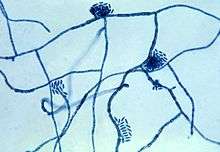Tinea nigra

| Tinea nigra | |
|---|---|
| Classification and external resources | |
| ICD-10 | B36.1 |
| DiseasesDB | 32450 |
| eMedicine | derm/890 |
Tinea nigra (also known as "superficial phaeohyphomycosis,"[1] and "Tinea nigra palmaris et plantaris"[1]) is a superficial fungal infection that causes dark brown to black painless patches on the palms of the hands and the soles of the feet.[2]:311
Causes
This infection is caused by the fungus formerly classified as Exophiala werneckii, but more recently classified as Hortaea werneckii.[3] The causative organism has also been described as Phaeoannellomyces werneckii.[4]
Diagnosis
Diagnosis of tinea nigra causing fungus is made on microscopic examination of skin scrapings, mixed with potassium hydroxide (KOH).[5] The KOH lyses the nonfungal debris.[5]
Treatment
Treatment consists of topical application of dandruff shampoo, which contains selenium sulfide, over the skin. Topical antifungal imidazoles may also be used, such as ketoconazole. This is the same treatment plan for tinea or pityriasis versicolor.
See also
References
- 1 2 Rapini, Ronald P.; Bolognia, Jean L.; Jorizzo, Joseph L. (2007). Dermatology: 2-Volume Set. St. Louis: Mosby. pp. Chapter 76. ISBN 1-4160-2999-0.
- ↑ James, William D.; Berger, Timothy G.; et al. (2006). Andrews' Diseases of the Skin: clinical Dermatology. Saunders Elsevier. ISBN 0-7216-2921-0.
- ↑ Murray, Patrick R.; Rosenthal, Ken S.; Pfaller, Michael A. (2005). Medical Microbiology (5th ed.). Elsevier Mosby.
- ↑ Pegas JR, Criado PR, Lucena SK, de Oliveira MA (2003). "Tinea nigra: report of two cases in infants". Pediatric dermatology. 20 (4): 315–7. doi:10.1046/j.1525-1470.2003.20408.x. PMID 12869152.
- 1 2 Gladwin, Mark; Trattler, Bill. Clinical Microbiology (4th ed.). p. 196.